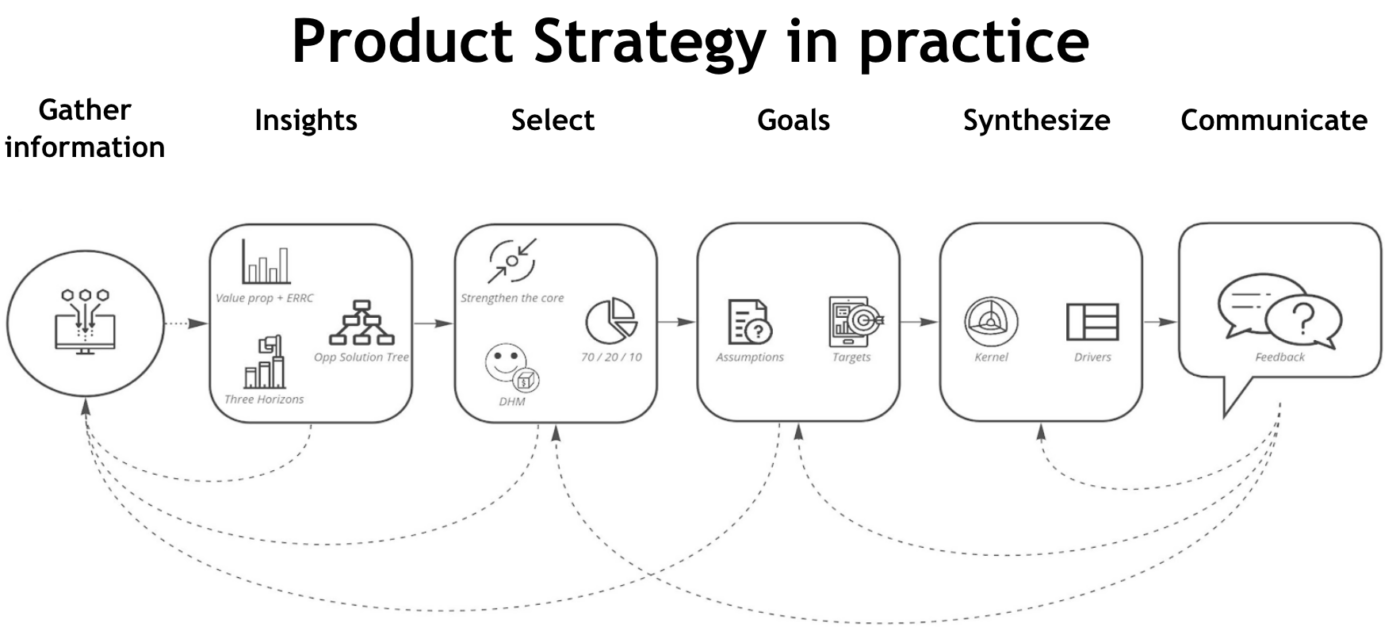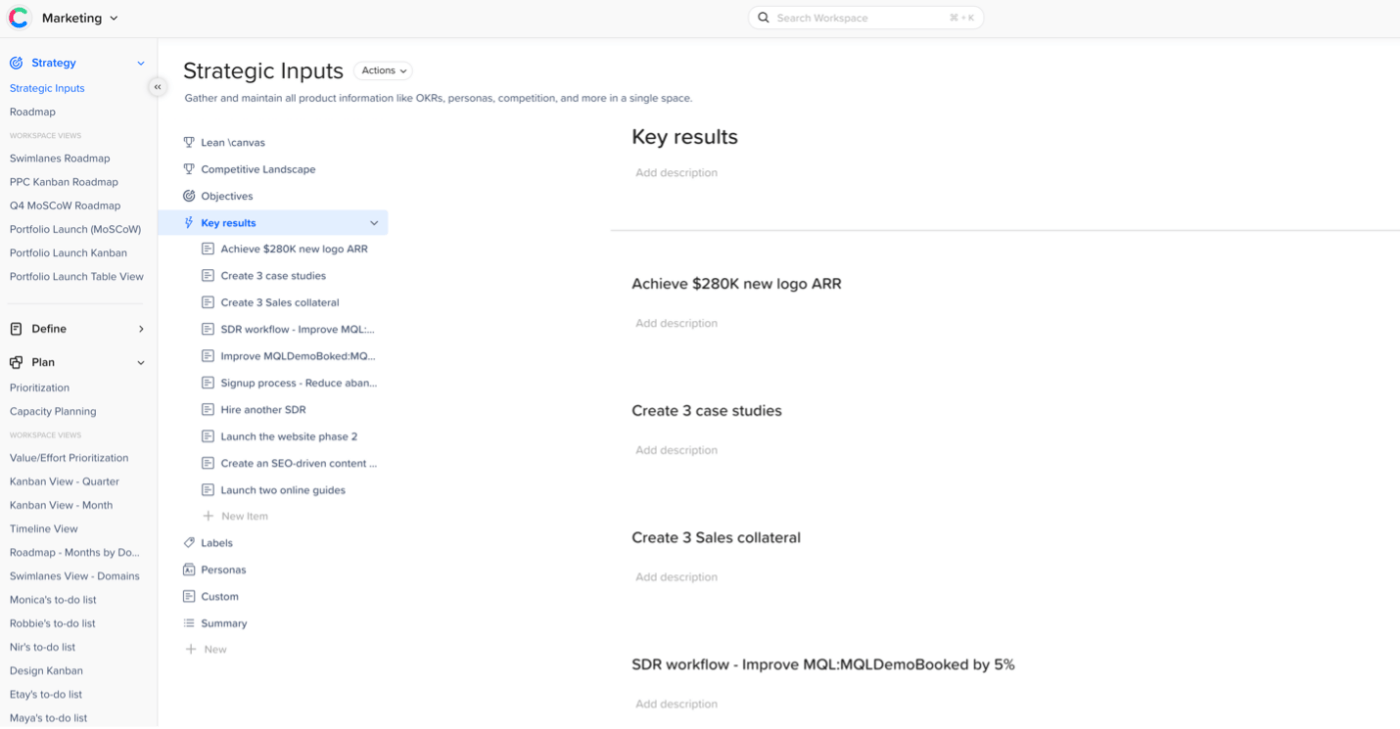What Is a Product Strategy?
A product strategy is a blueprint that summarizes how a company plans to provide a solution to address a specific market challenge, how the product will offer unique value to customers, and what success will look like once the company releases the product to the market.
Why product strategy is critical to success
As you can see from the definition above, a product strategy is only a high-level plan. It will not contain a detailed description of the proposed product’s features, user experience, marketing campaign ideas, pricing options, and other decisions.
But for the product team to have the best chance of making the right decisions when it comes to those details — and a hundred others — the team will need to be able to continually refer to a strategic reference point to guide their decisions. That guide is a clear, data-supported, and effectively articulated strategy for the product.
This is one of the main reasons that developing an effective product strategy is mission-critical to the product’s eventual success. The strategy informs all of the follow-on decisions about the product’s development, how to prioritize what product functionality to work on first, how to position the product for its intended customer base, and where to allocate resources.
Let’s view this from the other angle: If a product team fails to devise a well-thought-out product strategy first, all of its downstream decisions — what features to build, how to articulate the product’s value proposition to users, etc. — will be ad hoc decisions or even flat-out guesses.
Key Components of Product Strategy

Now that we’ve established the importance of product strategy, let’s discuss the key ingredients to making yours effective.
Identifying a target market and customer needs
Before you begin creating even a high-level plan for your product concept, you’ll need to research the market looking for an unmet need or a specific challenge that a group of people or business — the key personas for your product concept — are experiencing and would pay to resolve.
The business and monetary components of your research will be critical here to ensure your product has a chance of achieving real success for your company. You don’t want, for example, to invest in building a product that solves a real challenge but for a market segment too small to make the product profitable, or that many people would like but wouldn’t pay for.
With that in mind, you should proceed to the next phase in developing your product strategy only if this initial research leads you to the following:
- An unmet need or challenge in your target market.
- A solution with a large enough user base to make building the product profitable.
- A product users say they (or their companies) would be willing to pay for.
Setting the vision and objectives
Now that you’ve identified a problem worth solving, for a market segment willing to pay to resolve that problem, you can begin establishing the vision and goals for your proposed product.
Your product vision should be a high-level mission statement for your product. LinkedIn’s product vision, for example, is “to create economic opportunity for every member of the global workforce.” A clear and compelling vision can be valuable to your product’s success not only in these early concept stages but throughout its lifecycle as well — by helping you and your team stay aligned on the big picture objectives you’re trying to achieve with the product.
With the vision set, you can also begin establishing product goals, such as metrics for obtaining users, revenue, and market share.
Analyzing competitors and industry trends
You’ll also want to research the industry to determine how well similar types of products (or products for customer segments similar to the one you’re targeting) are performing. This will give a sense of what’s possible with your solution and might also help you set or adjust expectations based on the objectives and goals you’ve outlined above.
And of course you’ll need to investigate competitive solutions to determine what you’ll be up against with your product. Keep in mind that the field of competitors might be broader than simply companies making products similar to yours.
If you’re planning a product that’s unique or differs from the field in some fundamental ways, you might also find your company competing with workaround solutions your prospective customers are using today.
Crafting a unique value proposition
If your product vision is primarily an internal mission statement — something to use as a strategic reference point for your cross-functional product team — you can think of your product’s unique value proposition as a customer-facing mission statement or promise you’re making with your product.
Uber, for example, offers customers this value proposition: “The smartest way to get around.” Slack promises to “Make working lives simpler, more pleasant, and more fun.”
Developing the product roadmap and defining priorities
At this point, you’ve used research and data to support your contention that there’s a potentially profitable market out there for your product, and you’ve come up with a compelling strategic story around the product to align and inspire your team (the product vision) and ultimately persuade customers to buy it (the value proposition).
Now it’s time to craft detailed user personas, writing user stories and features for a product backlog, and then working with your team to determine what elements should earn priority slots on your product roadmap.
An example of an effective product strategy model
You can use the steps above to form the basis of your product strategy process, or you can simply view them as a guide to the larger strategic stages you’ll need to go through to make your own process effective. There is no one-size-fits-all formula for creating a product strategy.
In fact, here’s another effective way you can organize your team’s process, created by author Nacho Bassino for the craft.io webinar, Uncomplicating Product Strategy.

Pro tip: centralize your product data in a digital hub
As you begin capturing the many elements you’ll need to build your new product — features, epics, personas, stories, stakeholder feedback, strategic inputs, etc. — one best practice is to centralize all of these items in one digital environment, such as the craft.io product management platform (shown below). That will make it much easier to make sure your team is staying aligned and moving forward according to your agreed-upon product strategy.

Best Practices for a Successful Product Strategy
We’ve reviewed many of the key ingredients needed for a product strategy. But to devise and execute a successful strategy, you’ll need to be mindful of several other important issues. Here are some examples.
Balancing short-term and long-term goals
As a product professional, you’ll always have fewer resources and less time for your product than you’d like. And because you’re trying to do more with less, it’s easy to fall into the trap of focusing only on immediate goals — push the product out the door by this date, get subscribers now, earn X revenue in the next three months, etc.
Those are strategically valid objectives. But you also need to pay attention to your long-term product goals as you’re prioritizing and allocating your limited resources.
Iterating and adapting based on user feedback
As we noted earlier, product strategy isn’t only an early-stage activity that you complete once and then follow to the letter for your product’s entire lifecycle. Your product strategy will inevitably change with time — and those adjustments will be partly the result of how the market reacts to your product.
Encourage feedback from both users and your internal stakeholders, and use that data to determine what to prioritize and how to allocate your resources.
Building a cross-functional team and culture
No single person or team can execute a successful product strategy in a vacuum. Bringing a product from concept to market launch and then through many stages of enhancement over time will require the shared inputs, unique insights, and effective coordination of many teams across your company.
So it’s extremely important that you establish a culture of cross-team communicating — particularly between the product and development groups — and encourage every team to share its learnings and ideas with other stakeholders.
And again, a best practice here is to make sure your product content is centralized in an end-to-end product management platform, like craft.io. That way, all teams can easily share and view relevant and up-to-date product data anytime.
Measuring and evaluating performance
You’ll also want to frequently revisit your product strategy to measure it against the KPIs or other metrics your team set to measure success: product usage, revenue, market share, cost to acquire new customers, churn rates, etc.

Remember, your product strategy doesn’t exist in a vacuum. It represents your best analysis at the time you drafted it, plus any adjustments you’ve made according to new data.
You’ll want to closely monitor your product’s performance against your success metrics to determine when and if it’s time to change strategy.
Creating a Successful Product Strategy Framework

To a large degree, each product strategy you craft will be unique, built around identifying a specific market problem and creating a specific product to solve it. If you follow the components of effective product strategy we outlined above — spotting an unmet market need, learning about your persona, researching the competition, etc. — you’ll find that those steps can help you develop your strategy with more confidence and efficiency. But because every product is (or at least should be) unique, you’ll need to start largely from scratch as you craft each strategy.
The good news, though, is that you can make the challenging work of creating product strategies easier — and the products that result from your strategies more successful — if you start with an effective product strategy framework.
Think of a product strategy framework as an overarching theme that unifies all the products your company creates and ensures that they’re all aligned with your company’s business objectives and vision. Amazon offers a great example.
Amazon’s product strategy framework
Amazon’s product portfolio is massive and varied: consumer products (Echo), business solutions (AWS), hardware products, software products, consumer services (cloud photo storage, free delivery), corporate services (Fulfillment by Amazon), and on and on.
When any product team in any Amazon business unit starts the product-creation process, they will need to do the challenging work of researching the market, looking for customer challenges or frustrations, analyzing the potential costs and benefits of executing on their idea, etc. But that team will never be starting completely from scratch, because they have Amazon’s product strategy framework as their initial guide. And the main principles of that framework include:
Customer obsession
Putting the customer experience first was Amazon’s initial vision and remains the company’s core brand promise. If a new product idea conflicts for any reason with this company mission, it won’t survive beyond the product team’s brainstorming session.
Continuous innovation
Another central promise of the Amazon brand is never to stand still, to continuously introduce unique, life-changing products and services. The company has even codified this concept in its leadership principle, “Invent and simplify.” With this framework in mind, if the team determines that a proposed new solution sounds like a me-too product, they will likely cross it off their list long before the idea makes it to the product strategy stage.
Think big
“Think big” is another Amazon leadership principle that informs the company’s product strategy. What this means for Amazon product teams is that the company tends to favor bold ideas over incremental enhancements. With this component of Amazon’s product strategy framework as part of their guide in brainstorming, a product team is more likely to focus on game-changing ideas than to search for solutions that could add only a small amount of value for customers – even for millions of customers.
Obviously, we can’t promise you that establishing a big-picture product strategy framework will lead to Amazon-level successes, but creating and sticking to an effective framework is one way to increase the chances that you’ll develop a winning product strategy.
Putting Your Product Strategy into Action
When you’ve completed the steps we discussed above and have a clear idea of your user persona, the challenge facing that persona today, the solution you plan to build to solve it, and a vision of what success will look like, it will be time to start putting this high-level plan into action.
Those initial action steps might include:
- Presenting your product strategy to key stakeholders.
- Prioritizing the first functionality for your Minimum Viable Product (MVP).
- Establishing rough timelines and budgets to complete the work.
And from there, the fun begins.
Try craft.io’s product strategy solution free































